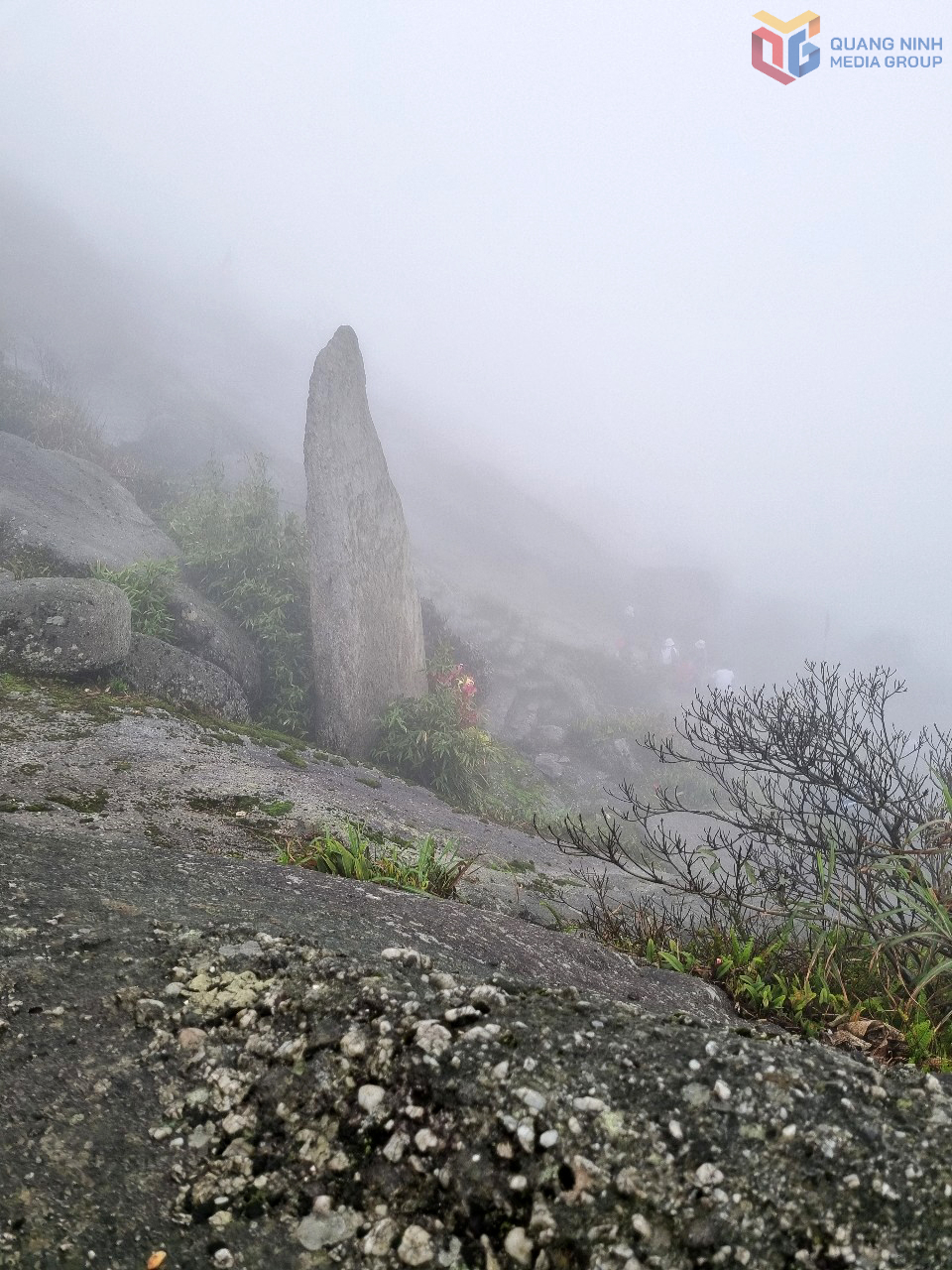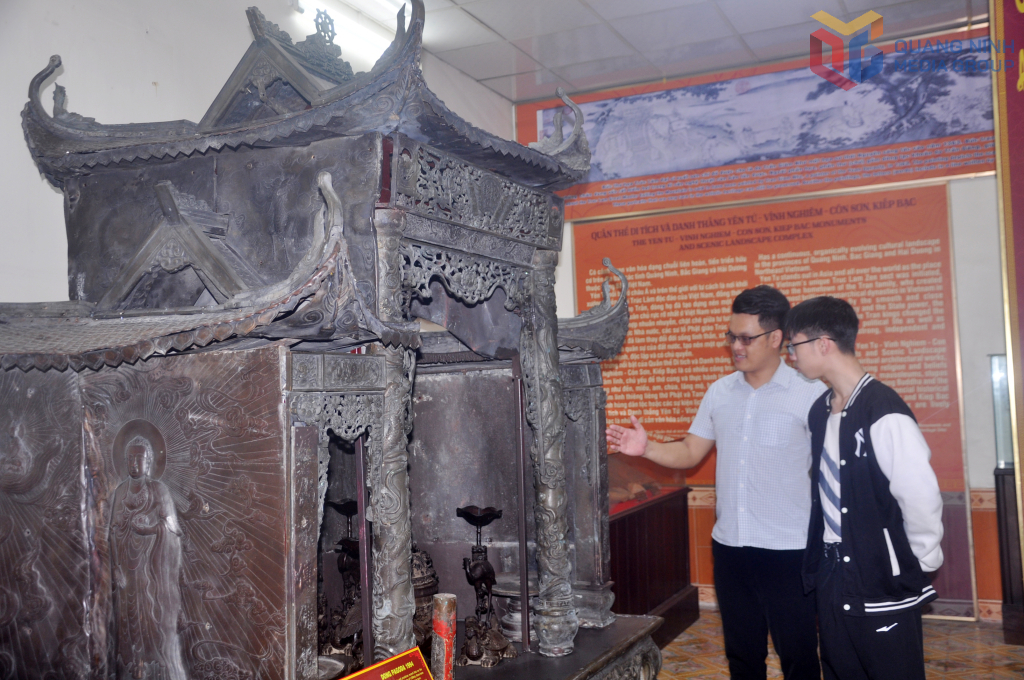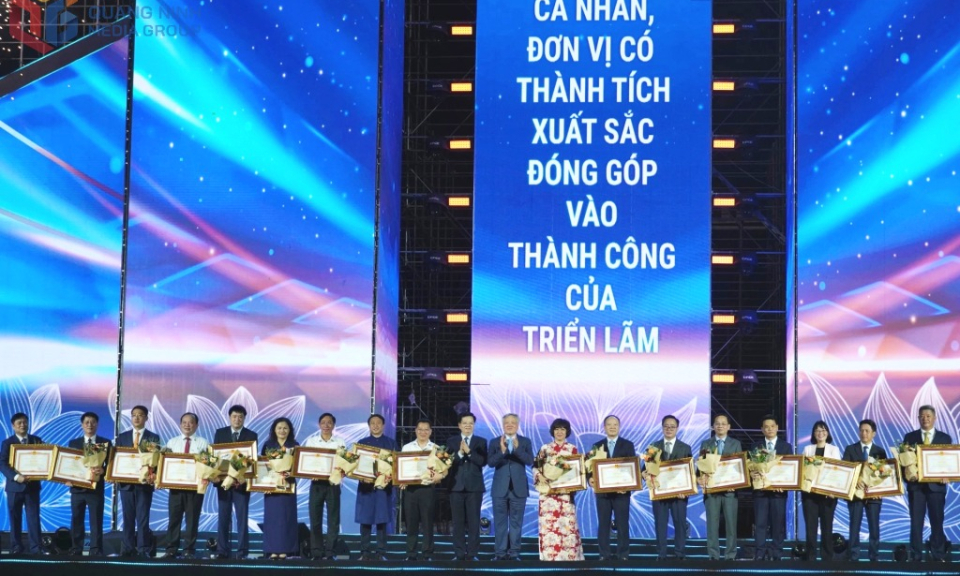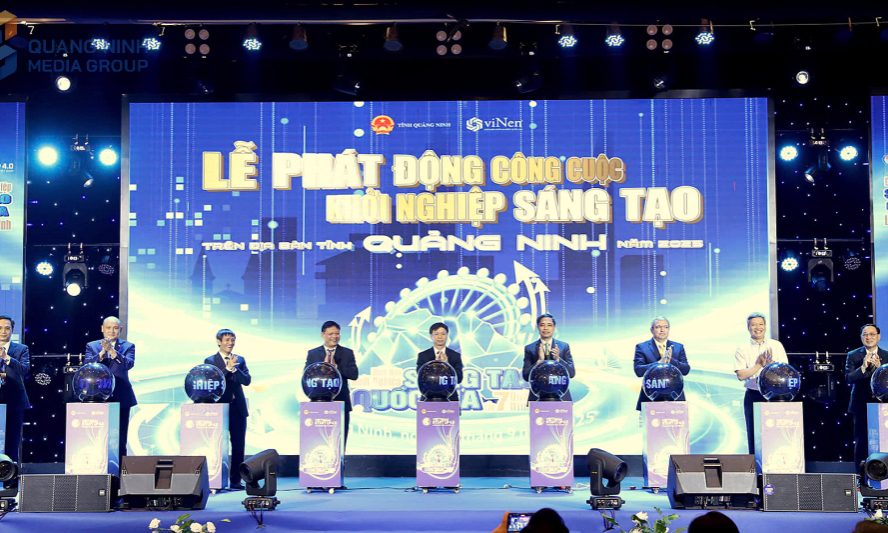Dong Pagoda: A sacred spiritual destination
Standing at an altitude of 1,068 meters, it marks the highest point of the Yen Tu relic and scenic complex, an important pilgrimage site associated with King Tran Nhan Tong, the founder of Truc Lam Zen Buddhism, Dong (Bronze) pagoda is a symbol of devotion, perseverance, and the profound spiritual journey of Buddhist followers in Vietnam.
According to scientific research, the entire Yen Tu Mountain was known as Tien Mountain (Fairy Mountain) 2,000 years ago, closely associated with legends recorded in ancient Vietnamese and Chinese texts. These texts describe it as the place where the immortal sage An Ky Sinh attained enlightenment and ascended to the heavens. Today, the stone statue of An Ky Sinh still stands near the summit of Yen Tu Mountain, in an area known as Thien Phu Thanh Hu (Heavenly Palace of Pure Emptiness).
The natural terrain of this area, shaped by geological formations over centuries, consists of numerous massive rock formations, many of which have collapsed or shifted over time. These unique natural features, combined with the mythological significance of the mountain, have led to the naming of several distinctive sites in the region. Some of these mystical locations include Chợ Trời (Heaven’s Market), Cổng Trời (Heaven’s Gate), and Bàn Cờ Tiên (Fairy Chessboard). These names evoke a sense of mystery and spiritual connection, offering visitors a glimpse into the deep cultural and mythical heritage of Yen Tu.
Later, as Truc Lam Buddhism expanded its influence, several Buddhist relics appeared at the mountain's summit. Among these are the statue of Buddha King entering Nirvana, commonly known by locals as the Reclining Buddha, and the Amitabha Buddha stone stele.
According to research, these relics date back to the Le Trung Hung period (17th–18th centuries), a time when Truc Lam Buddhism experienced a powerful revival. Similar to the earlier Taoist traces found on the mountain, these Buddhist relics were also closely integrated with the natural rock formations, reflecting a harmonious blend of religion and nature at Yen Tu's sacred peak.
The Ban Co Tien (Fairy Chessboard) later became the foundation of Dong Pagoda, situated at the highest point of Yen Tu Mountain. According to the historical record "Dai Nam Nhat Thong Chi", the pagoda’s foundation originally featured a stone chessboard, traditionally known as Ban Co Tien: "The Fairy Chessboard, along with the chess pieces, is made of blue stone, with beautifully inscribed characters, though its exact origin remains unknown."

The Buddha statue is located right in front of Dong Pagoda. Due to the steep and narrow terrain, combined with the high number of pilgrims visiting during the spring season, many visitors may overlook this large stone statue unless they pay close attention.
Dong Pagoda was first built during the Le Trung Hung period, estimated to be around the late 17th century to early 18th century. According to the historical record "Dai Nam Nhat Thong Chi", it is written:
"A court lady from the Trinh family built Dong Pagoda here, with a copper-tiled roof and two cast statues. In the year Canh Than, during the reign of Le Canh Hung (1740), thieves stole the copper tiles, leaving only the statues and wooden columns..."
Due to harsh weather conditions and the passage of time, multiple versions of Dong Pagoda have been reconstructed over the years at the summit of Yen Tu Mountain.
According to research, Dong Pagoda was rebuilt in 1930 during the reign of King Bao Dai, and a stone stele was inscribed. In 1993, a small-scale bronze pagoda was constructed through donations. The current Dong Pagoda, the largest version to date, was built in 2006-2007 as a representation of Nirvana in Truc Lam Buddhism, inspired by the architectural style of Dau Pagoda.
The entire pagoda is made of bronze, weighing 60 tons, with a total floor area of 16.55 square meters. It consists of 16 bronze columns with diameters ranging from 20 to 30 cm and heights between 2.2 meters and over 3 meters. The crossbeams are sculpted into dragon heads, while the four corners of the roof curve like a blooming lotus flower. The tiles resemble traditional Vietnamese shoe tips (mui hai), and the walls, railings, cranes, couplets, and dragon reliefs are all intricately cast in bronze, creating a vibrant and artistic masterpiece.

Dong Pagoda is not just a place of worship but also a crucial part of Vietnamese Buddhist culture and history. It is deeply linked to King Tran Nhan Tong, who, after abdicating his throne in the late 13th century, devoted his life to Buddhism and established Truc Lam Zen Buddhism on Yen Tu Mountain. Every year, thousands of Buddhist followers and tourists visit the pagoda, especially during the Yen Tu Spring Festival, which takes place from the 10th day of the first lunar month. Many people make the pilgrimage to pray for peace, health, and prosperity, while others come to experience the profound tranquility of the mountain.
Reaching Dong Pagoda is a journey of both physical endurance and spiritual dedication. Visitors can hike through the ancient stone-paved trails, which takes about 3-4 hours, passing by significant landmarks such as Giai Oan Pagoda, Hoa Yen Pagoda, and the Hue Quang Stupa.
For those who prefer a more accessible route, a cable car system is available, reducing the travel time and allowing a 45-minute trek to the summit. Along the way, pilgrims and travelers are rewarded with breathtaking views of misty forests, ancient trees, and towering cliffs, creating a sense of serenity and connection with nature.
From the summit, Dong Pagoda offers a magnificent panoramic view of the surrounding mountains, where the clouds seem to merge with the land, creating a mystical and sacred atmosphere. The combination of spiritual energy, historical significance, and natural beauty makes Dong Pagoda a must-visit destination for those seeking a meaningful pilgrimage or a tranquil retreat away from the bustling modern world. The site is now part of the Yen Tu Special National Relic Site, recognized for its cultural, historical, and religious importance.
Preservation efforts continue to ensure that this sacred site remains a place of reverence for future generations.






